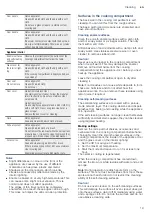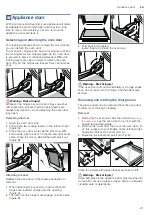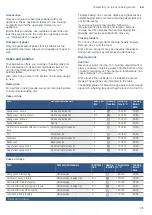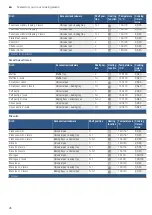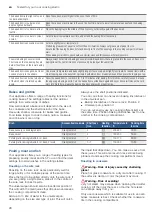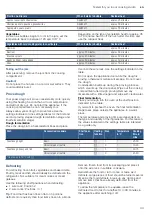
en
Tested for you in our cooking studio
32
Drying
You can achieve outstanding drying results with hot air.
With this type of preserving, flavours are concentrated
as a result of the dehydration.
Only use unblemished, fresh fruit, vegetables and herbs
and wash them thoroughly. Line the wire rack with
greaseproof paper or parchment paper. Drain the
excess water from the fruit and then dry the fruit
thoroughly.
If necessary, cut it into pieces of equal size or slice it
thinly. Place unpeeled fruit onto the dish with the sliced
surfaces facing upwards. Ensure that neither fruit nor
mushrooms overlap on the wire rack.
Grate vegetables and then blanch them. Drain the
excess water from the blanched vegetables and spread
them evenly on the wire rack.
Dry herbs on the stem. Spread the herbs out evenly and
slightly heaped on the wire rack.
Use the following shelf positions for drying:
■
1 wire rack: Position 3
■
2 wire racks: Positions 3 + 1
Turn very juicy fruit and vegetables several times. After
drying, remove the dried food from the paper
immediately.
In the table, you will find settings for drying various
foodstuffs. The temperature and drying time are
dependent on the type, moisture, ripeness and
thickness of the food. The longer you leave the food to
be dried, the better it will be preserved. The more thinly
you slice the food, the more quickly it will dry and the
more flavour it will retain.For this reason, the table
specifies setting ranges.
If you wish to dry food that is not listed in the table, you
should use the settings listed in the table for similar
food as reference.
Preserving
For preserving, the jars and rubber seals must be clean
and intact. If possible, use jars of the same size. The
information in the table is for round, one-litre jars.
Caution!
Do not use jars that are larger or taller than this. The
lids could crack.
Only use fruit and vegetables in good condition. Wash
them thoroughly.
The times given in the tables are a guide only. The time
will depend on the room temperature, number of jars,
and the quantity and temperature of the contents.
Before you switch off the appliance or change the
cooking mode, check whether the contents of the jars
are bubbling as they should.
Preparation
1.
Fill the jars, but not to the top.
2.
Wipe the rims of the jars, as they must be clean.
3.
Place a damp rubber seal and a lid on each jar.
4.
Seal the jars with the clips.
Place no more than six jars in the cooking
compartment.
Settings
1.
Insert the universal pan at level 2. Arrange the
preserving jars so that they do not touch each other.
2.
Pour ½ litre of water (approx. 80 °C) into the
universal pan.
3.
Close the oven door.
4.
Set Bottom heat
$
.
5.
Set the temperature to 170 - 180 °C.
Preserving
Fruit
After approx. 40 to 50 minutes, small bubbles begin to
form at short intervals. Switch off the oven.
After 25 to 35 minutes of residual heat, remove the
preserving jars from the cooking compartment. If they
are allowed to cool for longer in the cooking
compartment, germs could multiply, promoting
acidification of the preserved fruit.
Biscuits
With top/bottom heating at max. 190 °C.
With hot air at max. 170 °C.
Egg or egg yolk reduces the production of acrylamide.
Oven chips
Spread out a single layer evenly on the baking tray. Cook approx. 400-600 g at once on a baking tray so
that the chips do not dry out and become crunchy.
Tips for keeping acrylamide to a minimum
Fruit, vegetables and herbs
Accessories
Heating
function
Temperature in
°C
Cooking time in
hours
Pomes (apple rings, 3 mm thick, 200 g per wire rack)
1-2 wire racks
<
80
4-8
Root vegetables (carrots), grated, blanched
1-2 wire racks
<
80
4-7
Sliced mushrooms
1-2 wire racks
<
80
5-8
Herbs, washed
1-2 wire racks
<
60
2-5


